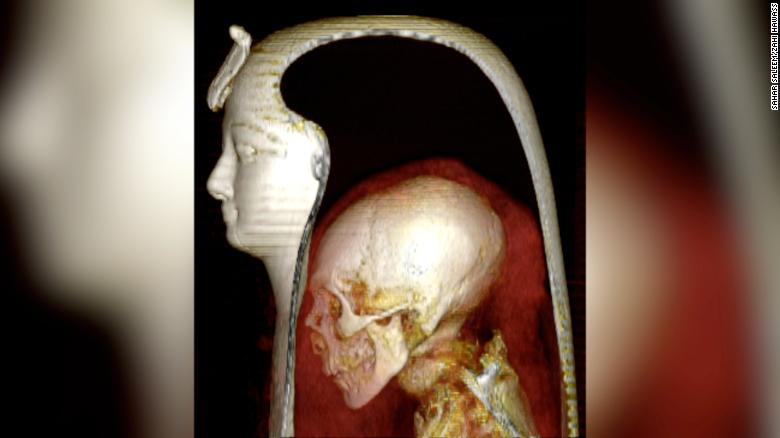Related video: They recreate the faces of three mummies over 2,000 years old 0:58
(CNN) -
Egyptian scientists digitally unwrapped the mummified remains of Pharaoh Amenhotep I, revealing tantalizing details about the Egyptian king's life and death for the first time since the mummy was discovered in 1881.
Decorated with flower garlands and a seductive wooden mask, the mummy was so fragile that archaeologists had never dared to expose the remains, making it the only Egyptian royal mummy found in the 19th and 20th centuries that is yet to be found. open for study.
Using non-invasive digital techniques, Egyptian scientists have used three-dimensional computed tomography (CT) to unwrap the 3,500-year-old mummy and study its contents.
Archaeologists find at least 800-year-old mummy in Lima, Peru
The mummy mask of Pharaoh Amenhotep.
"By digitally unwrapping ... the mummy and 'peeling' its virtual layers - the mask, bandages, and the mummy itself - we could study this well-preserved pharaoh in unprecedented detail," said Dr. Sahar Saleem, professor of radiology at the Cairo University School of Medicine and a radiologist for the Egyptian Mummy Project, in a statement.
What they discovered about the pharaoh's mummy
Saleem and his colleagues discovered that Amenhotep I was about 35 years old and 1.69 meters tall when he died.
He was also circumcised and had healthy teeth.
Inside the wrappers were found about 30 amulets and a unique gold sash.
advertising
Pharaoh's mummy, showing his skull and skeleton shrunken within bandages.
The pharaoh also had a narrow chin, a small, narrow nose, curly hair and slightly protruding upper teeth, Saleem said.
His study did not discover any injuries or disfigurements that could explain the cause of his death.
Amenhotep I ruled Egypt for approximately 21 years, between 1525 and 1504 BC.
He was the second king of the 18th Dynasty and had a largely peaceful reign during which he built many temples.
The researchers also found that the mummy had suffered multiple post-mortem injuries likely inflicted by ancient grave robbers, which, according to hieroglyphic texts, priests and embalmers subsequently attempted to repair in the 21st Dynasty, more than four centuries after it was mummified and buried.
DNA Reveals Unexpected Origin of Enigmatic Mummies Buried in Chinese Desert
The pharaoh's skull, including the teeth, which were in excellent condition.
Before studying the mummy, Saleem had thought that these priests and embalmers mentioned in the texts might have unwrapped the mummy to reuse some items as amulets for later pharaohs, which was common practice at the time.
But that was not the case, he said.
"We show that, at least for Amenhotep I, the priests of the 21st Dynasty lovingly repaired the wounds inflicted by the grave robbers, restored his mummy to its former glory and kept the magnificent jewels and amulets in place," Saleem said.
in the statement.
The research was published in the journal Frontiers in Medicine on Tuesday.
Mummies





/cloudfront-eu-central-1.images.arcpublishing.com/prisa/2P2FATFESJDD5BB6NR7VLSJ7QY.jpg)




/cloudfront-eu-central-1.images.arcpublishing.com/prisa/2C5HI6YHNFHDLJSBNWHOIAS2AE.jpeg)



